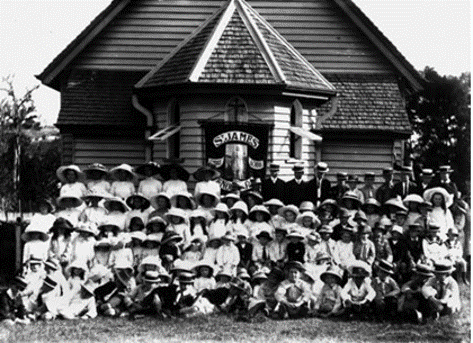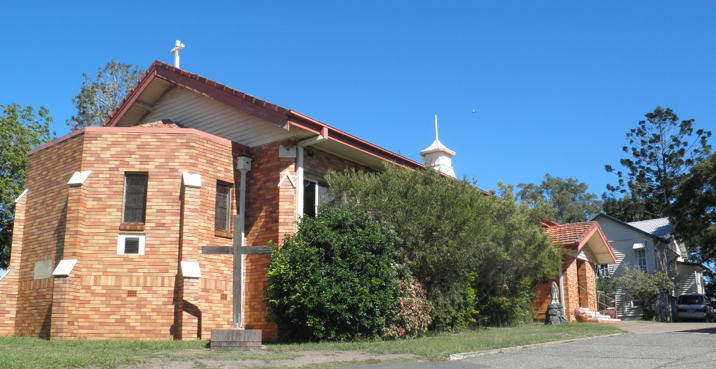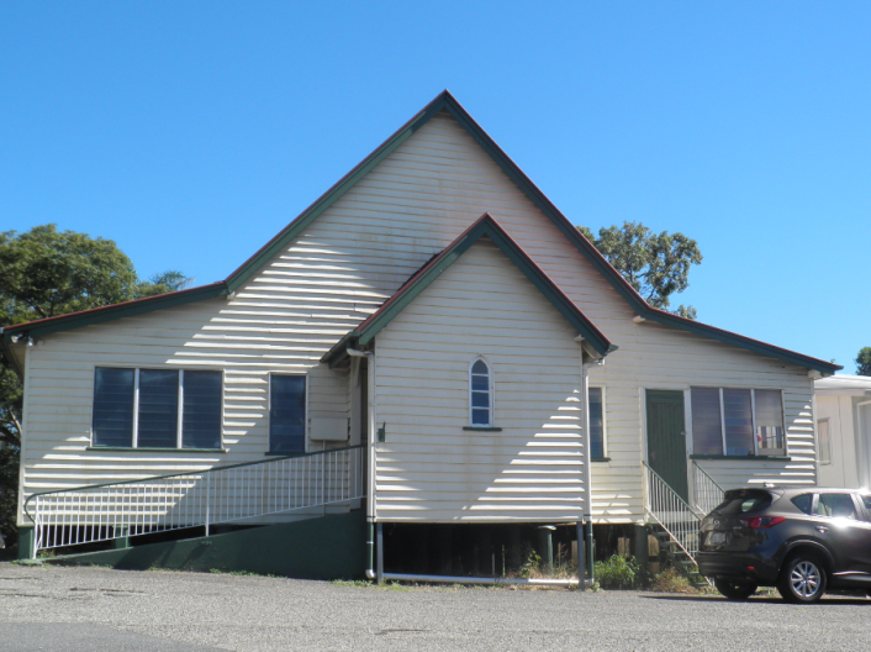Addresses
Type of place
Church, Hall, Residence (singular)
Period
Federation 1890-1914, Interwar 1919-1939, World War II 1939-1945
Addresses
Type of place
Church, Hall, Residence (singular)
Period
Federation 1890-1914, Interwar 1919-1939, World War II 1939-1945
The Anglican Church of St James at Newmarket has its origins in nearby Thurlow Street where a timber church was constructed in 1901. This church was relocated in 1921 to the present site at 58 Enoggera Road where it is included in the suburb of Newmarket.
The St James’ site also contains a timber rectory built circa 1925 and a brick church designed by the Brisbane architectural firm of Hall and Chambers, constructed in 1944 under wartime building restrictions. Since the construction of the brick church, the original church has been in use as a parish hall.
Lot plan
L48_RP209801; L46_RP209801; L44_RP209801; L42_RP209801
Key dates
Local Heritage Place Since —
Date of Citation —
People/associations
John Hingeston Buckeridge (Architect);Chambers and Ford (Architect)
Criterion for listing
(A) Historical; (B) Rarity; (G) Social; (H) Historical associationInteractive mapping
Lot plan
L48_RP209801; L46_RP209801; L44_RP209801; L42_RP209801
Key dates
Local Heritage Place Since —
Date of Citation —
People/associations
John Hingeston Buckeridge (Architect);Chambers and Ford (Architect)
Criterion for listing
(A) Historical; (B) Rarity; (G) Social; (H) Historical associationInteractive mapping
History
The first Anglican Church services in Kelvin Grove were held in the local Oddfellows’ Hall in 18961. In 1899, after the Anglican Church Mission proposed the construction of a new church in the locality, 84 perches (over 2,000 m²) in Thurlow Street (then Edith Street) were purchased from the McCook family for £62. The church’s design was allegedly based on a church at Goodna and was for a building which would accommodate 120 people and a choir of 12 boys.1
The new timber church was dedicated on Sunday 21 July 1901. In 1909, St James’ was separated from its parent parish of Christ Church at Milton. It later returned to Christ Church Parish in 1921. By 1917, the congregation of St James’ was large enough to have 120 children enrolled in Sunday School. According to the local community, two of the hitching posts used by church members outside St James’ Church have survived in Thurlow Street.
As the route to the northern towns of Gympie and Kilcoy and the Newmarket saleyards established in 1877, Enoggera Road (a continuation of Kelvin Grove Road from Red Hill) was a busy thoroughfare for both people and stock in the nineteenth century. In the 1870s, the provisional Kelvin Grove school opened in L’Estrange Terrace above Kelvin Grove Road and a hotel was established on the corner of Newmarket and Enoggera Roads, opposite the saleyard. The tramline was constructed along Enoggera Road at Kelvin Grove in 1901 and extended to Newmarket in 1903, encouraging further residential and commercial development and the provision of community facilities such as churches and schools. Newmarket State School on Enoggera Road opened in 1904.
In 1921, the timber church was moved with some difficulty along a wooden track to a new site on Enoggera Road where it continued to serve the needs of the local Anglican community. A fete was held in September 1923 to raise funds towards paying the debt incurred by the costs of moving the building. Some of the new site was set aside for the future construction of a permanent church.
By 1927, improvements to the interior of the church had been made and a timber rectory with a gabled roof and front and side verandahs had been built on the western side of the church. The rectory has since been turned 90 degrees on the site so that the side verandah (now enclosed) with its projecting roof gable now faces Enoggera Road. This possibly occurred in 1958 when Council approved alterations to the rectory.
In April 1941, the rector of St James’, Rev HJ Richards, called a meeting of parishioners to discuss the issue of building a new church on the site to replace the timber church which could no longer accommodate the growing congregation. £340 had already been raised for this project which had yet to come to fruition. During the meeting, a secret ballot resulted in a decision to proceed with the construction of a new church and more than £240 was pledged towards the cost. It was hoped that finances would permit a brick church.
Due to the wartime building restrictions introduced by the Federal Government under the National Security Act in 1940, permission to build the new church was postponed. However, architect George Rae called for tenders for a “brick and tile Church of England, Kelvin Grove” in April 19411. The application for a permit to build the church was referred by the Minister for War Organisation of Industry to his Queensland deputy before being referred again to the State Advances Corporation. In July 1943, permission was granted to construct the church and this time the architectural firm of Chambers and Ford was engaged to design it. Conditions imposed by the Government for the church’s construction included that only men not eligible for service in the military or the Civil Construction Corps (CCC) would be employed to build the church. In addition, a limit of £2,500 was imposed on the cost of the building.
Few other churches were built in Brisbane during World War II because of the difficulties caused by the shortage of labour and materials and government restrictions on new construction. A handful of churches were constructed in Brisbane in 1940-41 but after the bombing of Pearl Harbour in December 1941 and the entry of Japan into the war, building work was mostly for air raid shelters, military establishments and alterations to existing buildings. Building restrictions were one of the controls which continued into 1946 after the cessation of hostilities as the Chifley Government considered them necessary to ensure the success of the post war housing programme.
In August 1943, Chambers and Ford accepted the tender of builder, FA Pigeon,for the construction of the new church for St James’. Chambers and Ford was a successful partnership in Brisbane from 1920 to 1951 but Chambers was largely uninvolved in the practice and retired to Sydney in 1935. Eric Marshall Ford served as Office Manager for Chambers and Powell before going into partnership with Chambers.
Chambers and Ford designed many fine apartment buildings and residences in New Farm, Fortitude Valley, South Brisbane and other inner city suburbs. Fine examples of their work include Holy Trinity Anglican Church at Woolloongabba (designed by Ford, 1930), and ‘Ardrossan’ flats at Moray Street, New Farm (1934). St Margaret’s Church of England at Sandgate (1927) was also designed by Chambers and Ford. During the interwar years, Chambers and Ford were prolific in their domestic commissions, calling for tenders for over 110 houses in Queensland.
Construction of the new church commenced in August 1943 and on 5 September Bishop Dixon laid the foundation stone. After delays of several months due to manpower shortages, the church was officially opened and dedicated by Archbishop Halse on 21 May 1944. The church was constructed of brick with a tiled roof but due to the financial constraints of the permit from the State Advances Corporation, temporary timber vestries were constructed as well as temporary timber wall at the western end of the church to allow for future extensions. In September 1943, the Architectural and Building Journal of Queensland proclaimed that the new church of St James was “…the first Brisbane Church to be built since the Federal Government imposed building restrictions”.
After the construction of the brick church, the earlier timber church remained on the site and served as the parish hall. Council records reveal an application for additions to the hall in 1953. This was probably for the extensions along the northern and southern sides of the building. An application was subsequently approved for a room to be built under the hall in 1968. Photographic evidence indicates that some original features of the building, including a shingled turreted roof above the entrance porch and a shingled roof projecting over the front wall of the church have not survived.
Council approval was given for additions to the brick church in 1963 and again in 1964 for “vestries & chapel”. The church was further extended in 1982.
Today, the St James’ Church of England precinct continues to serve the social and spiritual needs of the local community.
Description
The former St James’ Church is a modest building clad with timber weatherboards and set back several metres from Enoggera Road. It is raised slightly at the front on stumps and has a small, enclosed front porch with a narrow, arched window.
The core of the building has a steeply pitched gabled roof, clad in corrugated metal sheeting, which extends over the additions along both sides. The original front stairs leading to the porch have been replaced on the northern side with stairs and on the southern side with a ramp.
The core (central nave) of the former church has a steeply pitched gable roof, and later additional symmetrical side aisles running down the northern and southern sides with lower pitched roofs, in a splayed line from the pitching point of the central gable. The roof is clad in corrugated metal sheeting, which extends over the additions along both sides. The original front stairs leading to the porch have been replaced on the northern side with stairs and on the southern side with a ramp.
Whereas the first church (above) on the site has its entry facing Enoggera Rd, the newer 1944 brick church, situated to the south of the first church and closer to the road, has its entry at the rear, southern side of the building, away from Enoggera Rd. The main roof over the central nave is a central gable with timber weatherboard end panels. The main wall cladding to the entire church is red brick, which creates a datum line around the building up to the pitching point of the main roof.
The apse/ chancel faces Enoggera Rd, with a half octagonal form with stepped brick buttresses at each point. The walls to the chancel form a parapet up to the brick datum of the main church, with a pitched tiled roof that has ridgelines that match the octagonal plan form it covers. There are four stained glass windows to the chancel, and an engraved, stone dedication plaque central to the end wall. A lower gable roof sits above the side entry and rear vestibule, and a secondary gable off the main gable covers the side vestibule off southern side of the apse. A small columbarium is located behind the church on the southern side.
A timber interwar rectory is located behind the brick church at the rear of the site. It has a gabled roof clad with corrugated metal sheeting and enclosed verandahs on the southern and eastern sides. The eastern side (which addresses the rear of the 1944 church) has a projecting gable.
The three buildings have not been inspected internally.
Statement of significance
Relevant assessment criteria
This is a place of local heritage significance and meets one or more of the local heritage criteria under the Heritage planning scheme policy of the Brisbane City Plan 2014. It is significant because:
Supporting images

Church (now parish hall) in original location in Thurlow St, c1908 (source: SLQ Neg no 61478)
References
-
Telegraph. 25 Jul 1947, p.5
-
Davidson’s Grant (Newmarket) Historical Group, Heritage Trail: Davidson’s Paddock, 2010, p.9
-
Brisbane City Council Building Cards
-
Brisbane City Council Detail Plan no. 681
-
Brisbane City Council Surveyor’s Field Book plan. 17 Aug 1936
-
Brisbane Courier, 18 Dec 1917
-
Brisbane Courier, 24 Sep 1923
-
Brisbane Courier, 22 May 1944
-
Telegraph, 18 Jun 1921
-
Telegraph, 24 Apr 1941
-
Telegraph, 20 May 1944
-
Telegraph, 25 Jul 1947
-
John Oxley Library Photograph Collection
-
Environment & Heritage Protection Heritage Register website. Entry for Holy Trinity Anglican Church, Woollooongabba. 601875. Retrieved 20 April 2017
Citation prepared by — Brisbane City Council (page revised September 2020)



